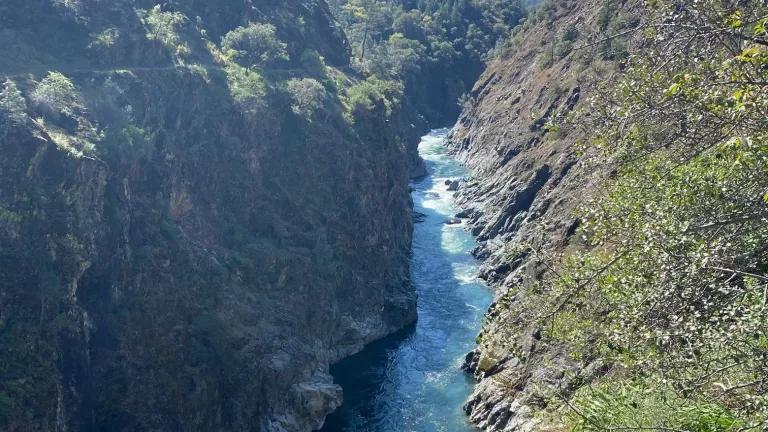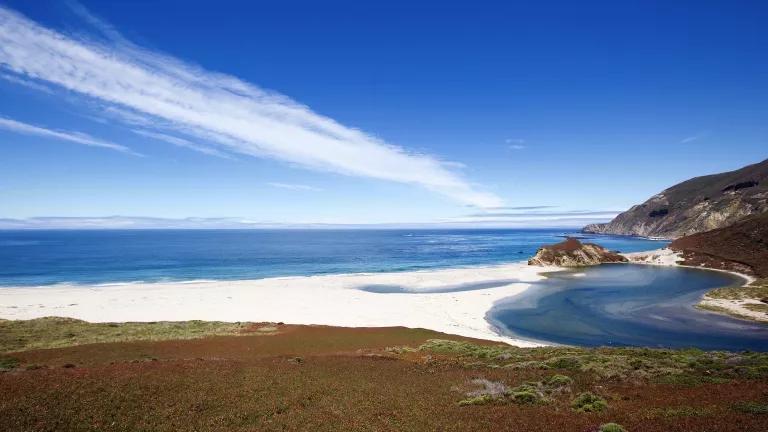Why NRDC Opposes the Proposed Sites Reservoir
As proposed, Sites Reservoir would make California’s water problems worse.
There will undoubtedly always be some folks who believe the myth that building new dams and reservoirs will be a silver bullet that solves California’s water supply challenges. The reality, of course, is that California already has constructed nearly 1,400 dams and reservoirs, and compared to the excessive and unsustainable demand for water in our state, new dams and reservoirs provide little water—at high cost. And of course, most dams and reservoirs have had devastating impacts on our native fish and wildlife, and the Tribes, fishing jobs, and communities that depend on their health. After all, even where dams don’t entirely block the flow of a river, they still take water from the environment (diverting and storing water that would have naturally flowed downstream in a river), nearly always storing that water for farms and cities to use later in the year or in subsequent years.
NRDC endorsed Proposition 1 in 2014, recognizing that although it included $2.7 billion for surface and groundwater storage projects, it was not likely to fund big environmentally destructive projects. At the time, I wrote a blog entitled “The Era of Big Dams is Still Over (Even with the Water Bond), which explained that the bond did not earmark money for particular projects, that the bond would only pay for specific public benefits of a storage project (since proponents claim that dams help the environment, this was their chance to prove it as the bond would pay for real environmental benefits), and that the enlargement of Shasta Dam and the proposed Temperance Flat Dam would not get funded and built. That blog has aged pretty well, including its prediction that it would not lead to the enlargement of Shasta Dam (ineligible for bond funding because if violates state law) or the proposed Temperance Flat Dam (withdrawn as infeasible because it was not cost effective).
Several other storage projects are continuing through the Prop 1 process, most of which are smaller projects that provide water supply to wildlife refuges or other real environmental benefits. But there’s still one environmentally harmful project seeking funding: Sites Reservoir. The proponents of Sites Reservoir are savvy myth-sellers, but it’s clear that this project harms salmon and the environment, and that it will not meaningfully address future droughts. In advance of the release of supplemental environmental documents this month, here’s why Sites Reservoir doesn’t work for California and should be rejected.
1. Sites Reservoir Threatens Salmon and other Fish in the Sacramento River and Bay-Delta
In our 2018 comments on the draft NEPA/CEQA document, NRDC remained open to the idea of a Sites Reservoir that would not harm the environment, while recognizing that the proposed operations of the project caused unreasonable harm to salmon, the Sacramento River, and the Bay-Delta ecosystem. State agencies also submitted comments, with the California Department of Fish and Wildlife finding the proposed reservoir would harm salmon, Longfin Smelt, and other species and that the environmental document failed to comply with CEQA. However, it was clear even then that the project needed to significantly reduce its planned water diversions and would likely yield less than half the water that the project originally proposed, in order to avoid harming salmon, Longfin Smelt, and other species.
Sites Reservoir proposes to divert water from the Sacramento River to fill the reservoir. But the project does not propose to divert water only during really wet years and extremely wet periods, but instead plans to divert water in most years, including averaging nearly 100,000 acre feet of water diversions in dry and critically dry years.

These excessive water diversions will harm salmon and other native species in the Bay-Delta watershed.
In the upper Sacramento River, numerous studies have shown that the survival of juvenile salmon migrating downstream depends on adequate river flows, with survival of these salmon decreasing dramatically as flows decrease. Numerous peer reviewed studies have demonstrated this relationship between flow and survival on the Sacramento River, including most recently a study by Cyril Michel and colleagues from NMFS (Michel et al. 2021). This study found that salmon survival drops dramatically when flow is less than 10,712 cfs (survival was 18.9% when flows are between 4,259 and 10,712 cfs, whereas survival was 50.8% when flows are between 10,712 and 22,872 cfs). Other studies have identified significantly higher flow thresholds (e.g., Iglesias et al. 2017). And importantly, there are juvenile salmon migrating down the Sacramento River from at least October to June, including not only threatened and endangered species like winter-run but also fall-run Chinook salmon, which form the backbone of the State’s salmon fishery.

Survival as a function of flow (in cubic feet per second). As flow increases, so does survival.
Source: Iglesias et al. 2017
But the adverse impacts from these water diversions aren’t limited to fish in the upper Sacramento River—the reduction in flows in the Sacramento River will also harm salmon and other native fish species downstream, all the way into and through the Delta and then into San Francisco Bay. For salmon, peer reviewed studies have demonstrated that reducing Sacramento River flows causes the survival of salmon migrating through the Delta to decrease when flows are less than ~35,000 cfs at Freeport (Perry et al. 2018, 2019). The reduction in Sacramento River inflows to the Delta will also reduce Delta outflow, harming species’ whose survival and abundance is dependent on Delta outflow, particularly Longfin Smelt (Nobrigra and Rosenfield 2018), but also Delta Smelt (Polansky et al. 2021).
While it’s true that the proponents have reduced the estimated water supply yield substantially since 2018, the proponents still refuse to even analyze scientifically credible flow requirements in the supplemental NEPA/CEQA document that are necessary to protect salmon, Longfin Smelt, and other species. Instead, the forthcoming NEPA/CEQA document analyzes a single operational scenario that allows water diversions that are plainly not protective of salmon, the Sacramento River, and Bay-Delta ecosystem:
| Proposed Flow Criteria | CDFW 2017 Criteria |
|
|
| Bypass flows at Wilkins Slough (cannot divert if flows are less than this amount) |
8,000 cfs in April and May 5,000 cfs in other months |
14,000 cfs from November through May 5,000 cfs in other months |
15,000 cfs from October to June |
| Bypass flows at Freeport (cannot divert if flows are less than this amount) | None | None | 35,000 cfs from October to June |
| Bypass flows for Delta outflow (cannot divert if flows are less than this amount) | D-1641 | D-1641 plus 44,500 cfs in March, April and May |
42,800 cfs in Jan, Feb and June 44,500 cfs in March, April and May Diversions limited to 2% of river flow when Delta outflow is less than 60,000 cfs |
| Limits on reducing floodplain inundation in the Yolo Bypass | Allows 10% reduction when flows over the weir are 6,000 cfs, and no limits on diversions at flows greater than 6,000 cfs | Not permitted to reduce floodplain habitat inundation | Not permitted to reduce floodplain habitat inundation |
The proposed operational criteria clearly do not provide the minimum bypass flows and other requirements that the California Department of Fish and Wildlife have been recommending for years. At a time when the Bay-Delta is in ecological crisis and state and federal agencies have recognized the need to significantly increase flows into and through the Bay-Delta, Sites Reservoir would decrease flows and worsen environmental conditions in the watershed. The revised CEQA/NEPA document also does not analyze allowable water diversions under the State Water Resources Control Board’s 2018 Framework, which proposed unimpaired flow requirements, which would require significantly higher flows and reduced diversions in most years than what the current proposal. And while the proponents have suggested habitat restoration to mitigate impacts to Longfin Smelt, there is no credible scientific evidence to support the idea that habitat restoration could compensate for the reduction in Delta outflow.
As proposed, this project will cause unreasonable harm to salmon and the health of the Bay-Delta ecosystem, and the proponents refuse to even analyze and consider biologically protective bypass flows and other environmental commitments.
2. Sites Reservoir Does Little to Address Future Droughts
The proponents have also claimed that Sites would provide huge benefits during the drought, but again, a closer look shows the reality isn’t as advertised.
For one thing, this will be expensive water. The proponents now estimate that Sites Reservoir will cost $3.9 billion to construct the project, a 30% increase from prior estimates. As a result, water from Sites is likely to cost more than $700 per acre foot on average—and that cost estimate does not include the additional costs to move water through the Delta, to pay to move water down the California Aqueduct and/or other canals, and the costs of water treatment for municipal and industrial users.
Second, in large part due to these costs, the Westlands Water District, Kern County Water Agency, and most other irrigation districts south of the Delta are not paying for Sites and will not get any water from the project (a few irrigation districts south of the Delta have very small shares in the project, like the Wheeler Ridge-Maricopa Water Storage District, which would get less than 1.6% of the total water supply from the project). The project will not benefit the vast majority of water districts that are getting a zero percent water supply allocation in 2021. Instead, the Metropolitan Water District of Southern California would get the largest share of the water because they pay the largest share of the costs (more than 25% of the non-state share of costs and water supply of the project).
Why is Metropolitan proposing to pay for this project, which will cost more than a billion dollars once debt financing charges are accounted for, when their recent Urban Water Management Plan claims that the agency has a surplus of water supply even during droughts? It seems that MWD staff have been paying for this project to benefit other water users, rather than focusing MWD’s spending on projects that benefit MWD’s ratepayers (like several large scale water recycling projects in Southern California). Indeed, once the costs of water treatment and transport are included, the large scale water recycling projects are far more cost-effective for MWD than Sites, as well as providing a drought-resistant water supply without the environmental degradation that Sites will cause.
Finally, even with the wholly inadequate bypass flows and other environmental protections, Sites Reservoir is now estimating that it will yield around 260,000 acre feet of water per year on average, with more water in drier years and less in wet years. But that means that in most future droughts, there will not be a lot of water in storage—and even less once biologically credible bypass flows and environmental protections are required. While Sites proponents claim the reservoir would have 1 million acre feet of water in 2021, even their modeling— which, again, assumes that they can divert water in critically dry years and without adequate environmental safeguards—shows there would have only been a total of 50,000 acre feet of water released from Sites during the prior drought in 2014-2015.
| Year |
Diversions from the Sacramento River |
Releases from Sites Reservoir |
| 2014 | 0 | 20,000 |
| 2015 | 50,000 | 30,000 |
Ultimately, paying for storage in Sites Reservoir doesn’t guarantee there will be any water in the reservoir in the next drought, and certainly not water that is cost-effective or an environmentally sustainable supply. California already has 1,400 reservoirs, and as President Obama’s science advisor John Holdren explained in 2014, “The problem in California is not that we don’t have enough reservoirs, it is that we do not have enough water in them.…. It wouldn’t help to build any more.”
As proposed, Sites Reservoir would make California’s water problems worse.

